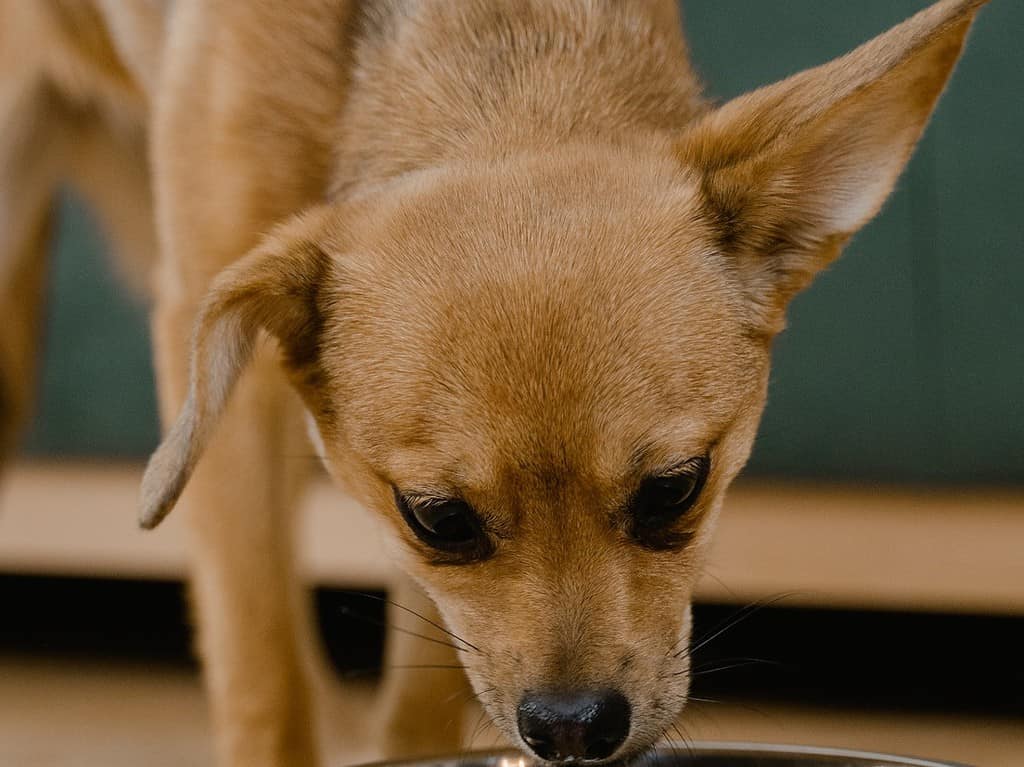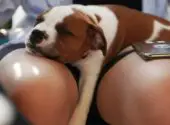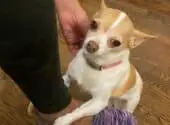So you just brought home a Chihuahua from the shelter. But instead of the signature pointy ears, your new furry companion has floppy ones.
It is a common misconception that all Chihuahua puppies are born with upright ears. However, due to insufficient stiffness or strength in the ear cartilage, some Chis may develop floppy or semi-floppy ears.
But wait – what makes their ears not develop enough stiffness or strength to keep them upright?
Nearly every pet owner has exactly the same problem. That is, finding the answer to this puzzle.
Until now:

Why Are Chihuahuas Ears Floppy?
Within the Chihuahua breed, there can be discrepancies in ear shape. While some Chihuahuas may have upright ears, others tend to have drooping or slightly erect ears. The reason for this variation are:
1. They’re still teething.
From the start of four months old to the end of six months old, a pup’s baby teeth will begin to lose and replace with their adult permanent teeth. This process mirrors teething in human babies, which can cause discomfort and an increased need to chew objects used to relieve itchy or sore sensations. For Chihuahua puppies specifically, teething can also trigger changes in ear shape.
During this stage, one or both of a puppy’s formerly erect ears may start to sag. It is hypothesized that this occurs due to the overuse of jaw muscles connected to the muscles located at the base of their ears.
Accordingly, excessive chewing can strain these muscles. As these muscles weaken, it diminishes their ability to keep a Chihuahua’s ears standing. This phenomenon is usually temporary; once adult teeth form and replace puppy teeth, ears return to an upright position.
It is essential to recognize that Chihuahuas with long hair require additional time for their ears to stand up than short-haired Chis fully.
2. They’re genetically predisposed to hanging ears.
As mentioned above, it is clear that genetics has a substantial influence on the shape of a dog’s ears as they typically adopt the form intended for their breed.
To be a responsible breeder, pairings between two dogs should always be carefully planned and considered to produce litters that fulfill the breed standard. One should think about the ear conformation of both parent breeds and their respective grandparents and five generations prior.
That said, an otherwise purebred AKC Chihuahua can be born with floppy ears, a genetic deviance that can occur randomly.


But as far as intentional breeding goes, although Chihuahuas with hanging ears are undeniably adorable, it should be avoided because they go against the standard and may produce dogs with an inherent genetic weakness. This trait can often be passed down to future generations.
3. Their ear cartilage is injured.
Injuries to the ear cartilage is one of the reasons why your Chihuahua has floppy ears, although some are born with this trait. Their fragility can make them vulnerable in rough handling, collisions, or fights among dogs.
Additionally, the ears can become chronically inflamed when exposed to conditions such as excessive scratching and ear infections. This inflammation can weaken the cartilage in the ears. This results in a loss of rigidity, making the ears hang on either side of the dog’s head.
Although short-term effects may permit the ear to return to its original form with proper treatment and care, persistent trauma will cause irrevocable long-term effects.
4. They have fewer neural crest cells.
Research has determined that fewer neural crest cells likely explain why your Chihuahua has floppy ears. These specialized groups of cells are an essential constituent of embryonic development in vertebrates, and their role is integral to processes such as the formation of facial features, skull bones, and skin pigmentation.
The number of neural crest cells in Chihuahuas is substantially lower than in dog breeds, which leads to issues with the development and structure of their ear cartilage.
During the formation of an embryo, neural crest cells contribute to the development of numerous structures by migrating and distinguishing into varied cell types. Notably, they become chondrocytes, which are responsible for ear cartilage production. Unfortunately for Chihuahuas, mutations or changes in genetic sequence are thought to impact the migration or reproduction of these vital neural crest cells, thus reducing their numbers and consequently impairing ear development.
The reduction in the number of neural crest cells present in Chihuahua ear development leads to a modification in the cartilage formation. The ear cartilage would typically be sturdy and rigid enough to support their ears to stay erect. However, without as many neural crest cells, the cartilage loses its rigidity, letting the ears drop.
It is essential to consider the various impacts of neural crest cells on development. These cells play a role in the structural formation of vital components, including those of the skull, jaw, and teeth. Therefore, Consequently, it is likely that any genetic mutation negatively impacting these cells could affect the Chihuahua’s anatomy.
5. They have ear infections and allergies.
The Chihuahua’s unique anatomy makes them particularly prone to ear infections. They are distinguished from other breeds by their slim ear canals and delicate skin surrounding them, which increase the risk of developing an ear infection. These infections accumulate moisture, microorganisms, and yeast in the affected region, consequently causing inflammation and pain. Moreover, complications related to this disease may result in changes in shape, like drooping or folding ears.
Allergies can also significantly impact Chihuahuas, leading to floppy ears. Common allergens such as food substances, mold, pollen, and dust mites can trigger allergic reactions in dogs that may result in itching, scratching, and frequent head shaking due to irritation. Over time this constant movement of the ear flaps causes them to become weaker and less supported, which gives the appearance of floppiness.
Additionally, exposure to allergens can result in extended inflammation and irritation within the ear canal, leaving it more defenseless to bacterial infections. This further compromises the cartilage and tissue supporting the ears, adding to their drooping nature.
6. Their diet is unhealthy.
A lack of proper nutrition is unlikely to be the main contributing factor to why your Chihuahua has floppy ears. This trait is primarily determined by genetics and not due to dietary intake. As we have noted, the floppy ears are due to weak cartilage lacking the strength to support an upright position and shape.
But here’s the thing: A dog’s nutritional needs are fundamental to their health and development. Deficiencies in certain nutrients may cause restricted growth, weak cartilage structure, or other overall health issues, which can detrimentally affect their ear health too.
Why A Balanced Diet Is Important For Chihuahua’s Health
Inadequate nutrition or the absence of essential nutrients during critical growth stages may harm a Chihuahua’s health and development, including the structure and stability of its ears.
So if you are set on having a Chihuahua with those trademark standing ears, be sure to provide a balanced and nutritious diet.
- Consider the quality of protein when it comes to supplying nutrition for a Chihuahua. High-quality proteins will support muscular growth and recovery. Sources include poultry, such as chicken or turkey; fish; eggs; and cottage cheese.
- It also helps if the Chihuahua has the right balance of carbohydrates in their diet due to their size. Incorporating whole grains, sweet potatoes, and vegetables into your dog’s diet provides essential nutrients and fiber while regulating blood sugar levels.
- A nutritionally balanced diet should also include a generous amount of healthy fats. These essentials supply fatty acids, which are vital for having a healthy coat and skin. Healthy fats can be obtained from fish, flaxseed, and small quantities of olive oil.
- Fruits and vegetables offer impressive levels of nutrition, with high concentrations of vitamins, minerals, and antioxidants. For Chihuahuas that depend on these nutritional sources to remain healthy, carrots, blueberries, spinach, brussel sprouts, and broccoli are beneficial choices.
Portion Control Is Key
Monitor portion sizes to prevent excessive weight gain or obesity, which may cause various adverse health effects. Chihuahuas have small stomachs, so meals should be distributed in smaller portions at regular intervals throughout the day. Keeping track of their weight and modifying food amounts appropriately is integral for upholding an optimal fitness level.
7. They have poor hygiene.
Failure to regularly clean and maintain Chihuahua ears can encourage the growth of bacteria, yeast, and mites. These organisms can develop into ear infections which cause inflammation in the tissue of the ears. This inflammation will pressure the cartilage, maintaining their ear shape and causing them to droop or flop over time.
In addition, inadequate hygiene practices may include failing to dry the ears properly after bathing or exposing them to excessive humidity. This moisture accumulation in the ear canals gives bacteria and yeast an ideal environment to multiply, leading to potential cartilage damage.
Chihuahua owners must include ear cleaning and maintenance as a routine. This should be done gently with a damp cloth or as directed by the vet using specialized solutions. Caution should always be exercised to avoid inserting anything deep into the ear canal, thus preventing injury. Moreover, it is vital to ensure that any moisture in the dog’s ears resulting from bathing or exposure to water is dried correctly afterward.
8. They have Domestication Syndrome.
The scientific concept of domestication syndrome explains why your Chihuahua has floppy ears.
Domestication syndrome is a collection of physical and behavioral qualities observed over many generations due to the human-controlled selection process of various domesticated species. These traits may include floppy ears, altered tails, reduced body mass, reduced brain size, and more.
The domestication of Chihuahuas has caused certain physical features to vary from the ancestral form of wolves, including floppy ears. This is thought to be due to selective breeding conducted by humans who preferred softer features which gave the a more juvenile look – something they likely find attractive.
9. They have low or high adrenaline levels.
Chihuahuas possess a unique characteristic: the ability to vary their ear position daily. This can manifest in several ways, including both ears upright or floppy and one ear up and one down.

The physiological motivation for this is linked to adrenaline levels. The adrenal glands release adrenaline hormones, otherwise known as epinephrine, in response to stress and excitement.
If your Chihuahua’s ear shape is erect today and then drops the next day, this may indicate fluctuating adrenaline levels. Figure out what’s causing these changes, whether your dog is stressed, relaxed, sad, or happy.
How To Recognize Erect versus Floppy Ears in Dogs
Erect or standing ears are common in German Shepherds, Doberman Pinschers, and Siberian Huskies. This trait gives these dogs an attentive appearance, always vigilant to all surrounding noises and movements.
Conversely, breeds such as Basset Hounds, Beagles, and Cocker Spaniels are known for their floppy ear type. This drooping appearance creates a welcoming expression for the dog.
You should be able to differentiate erect ears from floppy ones for breed identification and health-related issues.
Some breeds with erect ears are more vulnerable to ear infections caused by a lack of air circulation in the ear canals. You should practice frequent ear cleaning and grooming habits to help ensure these animals do not experience discomfort or other medical complications. Comparatively, breeds with floppy ears are prone to ear problems due to inadequate airflow and long-term moisture accumulation. The folded structure of the ears presents a humid environment, providing an ideal breeding ground for bacteria and yeast infections.
Additionally, dogs with upright ears may typically be more aware of their environment due to heightened alertness, activity levels, and sensitivity to external stimuli, making them suitable for working roles where a greater level of responsiveness is required. Such a trait may also allow them to demonstrate strength in agility and obedience training.
In contrast, dogs with floppy ears tend to be calmer and more laid-back. Their easygoing personalities make them ideal pets for families with kids and other pets.
When Do a Chihuahua’s Ears Stand Up?
If you look at a litter of Chis, you will notice that all the ears are flopping due to a lack of muscular strength. This will improve as the muscles get stronger, but not overnight.
It’s typical for Chihuahua owners to stress out when their pup’s ears will perk up! Remember that those little flappy things may go from flopping down to standing straight irregularly until the muscles at the base of each ear develop sufficient strength to keep them standing erect.
From 8 to 12 weeks of age, most puppies develop erect ears. As a result, when bringing a puppy home at this age, their ears are usually already adjusted in the upright position. However, certain cases demonstrate that ear tips may sometimes curl back slightly.
A Chihuahua puppy with upright ears or even slightly curled ones at an early age will likely have fully erect ears post-teething due to the temporary weakening of the cartilage during the said period.
How Can I Fix My Chihuahua’s Floppy Ears?
It is unnecessary to take action if your Chihuahua’s ears flop as long as the animal appears content and healthy. Should a desire arise to alter the physical shape of the ears, then some steps could bring about the desired outcome.
Taping the Ear
Some Chihuahua puppy owners use taping to encourage their dog’s ears to stand upright.
This technique involves using a mild, non-irritating adhesive tape to attach the base of the ear to the top of the head, thus causing an upward tension that can help straighten them out. However, it is worth noting that older dogs may find this painful and uncomfortable.
Surgical Cropping and Implanting
Surgical cropping and implanting have stirred up considerable controversy due to ethical considerations, leading many countries, such as the United States, to enforce strong regulations or completely ban the practice. This procedure is often used to give Chihuahuas their signature erect ears.
This surgical procedure modifies the contours and structure of the dog’s ears to make them stand upright. This consists of trimming sections of the ear flaps while implanting a rigid material to support and keep the ears raised.
Those who support surgical cropping and implanting hold that these procedures improve the Chihuahua’s aesthetic beauty, creating conformity to breed standards. Additionally, there are claims that these surgeries may guard against ear infections or conditions linked to having droopy ears, as erect positioning enables better airflow.
However, numerous veterinary associations and animal welfare groups are firmly against this practice. Criticisms arise from the unnecessary physical changes it imposes on dogs with potential pain, distress, and medical complications. These groups maintain that humans are selfish as their intent is solely for profit and satisfaction, compromising the dog’s safety and comfort.
How To Make A Chihuahuas Ears Stand Up Naturally?
Healthy ear cartilage can be supported through a nutritionally balanced diet containing sufficient proteins, minerals, and vitamins. Supplementing with omega-3 fatty acids may provide further benefits in keeping the ears upright.
Another aspect that should not be overlooked is exercise. Routine physical activity can aid the development of muscle tone around the ears. Participating in activities like walking, playing, and even training sessions supports your Chihuahua’s muscular health and may naturally help its ears to stand up.
Additionally, practice good grooming habits. Regularly cleaning the ears and ensuring no wax buildup or infection can help maintain healthy ear cartilage. Additionally, some pet owners have found positive results by massaging the base of the ears; this increases blood flow and strengthens the muscles in that area.
Despite these efforts, it’s crucial to understand that not all Chihuahuas are born with naturally upright ears. Genetics plays an important part in the formation of its ear structure. Therefore, it may be better to appreciate your Chihuahua’s natural features instead of fulfilling your desire for pointy ears in a pet.
Frequently Asked Questions
Do my Chihuahua’s floppy ears affect hearing?
Regardless of their position, the ears of Chihuahuas serve their purpose: to hear sound. Although upright ears can provide more efficient sound reception, Chis with floppy ears can still hear sounds accurately.
Can Chihuahuas with floppy ears have their ears become erect or stand up later in life?
During the growth and development of young Chihuahuas, their ears may be subject to change. Teething can cause a temporary drooping or change of shape in certain breeds, including Chihuahuas. As this period passes, the ears start to stand up again.
However, it is unlikely that an adult Chihuahua with naturally floppy ears become erect unless humans intervene, such as when the vet performs surgical cropping and implanting. There are also specific measures that promote upright ears without professional help, such as massaging and taping the ears.




